5 facts about Scoliosis:
- Scoliosis is the sideway curve of the spine but it can also rotate or twist.
- It evolves with age, due to aging and arthrosis of the spine making its deformation progress.
- There are different types of Structural scoliosis: The "C" shape (thoracic, lumbar, or thoracico-lumbar). The "S" shape (combined). There is also Functional scoliosis, curvature caused by muscular asymmetry or leg length discrepancy.
- 80% of scoliosis are idiopathic meaning unknown causes.
- It can be diagnosed through X-ray with the Cobb angle: 10° to 20° = mild scoliosis, 20° to 40° = moderate, over 40° = severe.
Is resistance training recommended/safe with scoliosis?
Resistance training is essential as it strengthens the muscles which support the spine. Resistance training can help with stability, increasing bone density and improving posture. However, caution needs to be taken to ensure it does not worsen symptoms, if done improperly. It’s also important to understand that clients with scoliosis aren’t “compromised” or “weak”.
Is it safe to lift? Is asymmetry a concern for squatting?
Different mobility requires different cues like any Client, but the main reassurance scoliotics need is that scoliosis is a structural deformity, not a muscular deformity. Resistance training loads the muscle, not just the spine.
Developing a strong core is imperative to strengthen abdominal and the lower back to balance and stabilize the posture. Exercises to help with this include:
- Kneeling cable anti-rotation hip trust,
- Superman,
- Flat bench leg raise.
Barbell exercises are not dangerous when implemented effectively and safely can improve symptoms and reduce pain. During a barbell exercise you may see, the bar tilt while moving or standing still, hip shift or knee cave during movement or one shoulder or hip higher than other.
If significant asymmetries appear to be there at all reps, all sets and there is no pain, it is likely to be their body structure, not a breakdown in techniques. Technique breakdown = substantial load, more likely at the end of a set when more fatigue and intensity is high or numerous sets in a row. The deviation is not there at lower loads and can be corrected.
Adapted movements postural associated with scoliosis = there at all the time, more focus on keeping the motion consistent as the weights get higher to not see a technical deviation in form from where the client was moving with lighter weights.
If they have pain in their day-to-day life, outside of training, address those first before starting training under the bar. Once the day-to-day pain is reduced to a 4, can start a BB workout.
Great athletes with scoliosis: Lamar Gant powerlifter with combined scoliosis 74 and 80 degrees holds the world record for deadlifting 300kg. Usain Bolt, the world's fastest human has spinal curvature greater than 40 degrees. 8 times gold medal winner, WR holder in 3 events, 11 times world champion. Jessica Ashwood, Australian swimmer with severe scoliosis, bronze 400m world championship in 2015 participated in Rio 2016 Olympic games.

